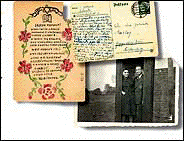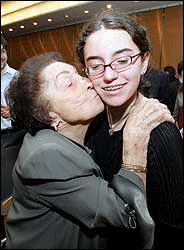|
A time capsule from
the Nazi Labor camps,
carefully preserved
|
Letters posted with Hitler stamps and inky Z's
for "zensiert," or censored. Tattered diary
pages in Yiddish. The photograph of a young
woman and her first love, peeking from the
darkened doorway of a barracks. To those
educated in the ways of the Holocaust, the most
startling aspect of these documents is that they
survived, and their bearer with them.
|

|
|
|
Postcards
and a photograph from "Letters to
Sala," at the New York Public Library.
[Michelle
V. Agins/The New York
Times]
|
|
|
|
|

|
|
|
Sala
Garncarz Kirschner with her
granddaughter Abby Kirschner at a
public reading of her letters, March 8,
2006. [New
York Public Library, Dorot Jewish
division/Sala Garncarz
Collection.]
|
|
Now they are on view through June 17 at the New
York Public Library, in the exhibition "Letters
to Sala": more than 100 postcards, letters,
photographs and diary entries (out of a total of
300) that chronicle one woman's experience of
the nightmare that unfolded as thousands of Jews
from western Poland were transported to Nazi
forced labor camps.
They speak
to the life of Sala Garncarz, who from the age
of 16 to 21 worked in seven camps &emdash; and
painstakingly saved every paper that passed
through her hands.
Encased in
glass, the yellowed documents, their Yiddish,
Polish and German script faded across 60 years,
are redolent with frustration and longing. Each
is labeled with a summary of its contents; about
30 letters are translated in full on electronic
screens. Photographs of the Garncarz family in
happier times hang on the walls.
Ms.
Garncarz, now Sala Garncarz Kirschner, and her
daughter, Ann Kirschner, presented the letters
to the library's Dorot Jewish division in April
2005. They form a time capsule of extraordinary
breadth from a less documented arm of the Nazi
camp system, said David S. Ferriero, director of
the research libraries.
Ms.
Kirschner hopes to pass on her mother's legacy.
Her book, "Sala's Gift," is to be published by
the Free Press in November, and a documentary
and a play about Mrs. Kirschner are currently in
development.
The
letters tell of a past locked away by a young
woman who hoped never to resurrect it, and of
the eventual understanding between a mother and
a daughter.
"These
letters, I knew that I've got to have them,"
Mrs. Kirschner said in a telephone interview
last Sunday, her 82nd birthday and 60th wedding
anniversary. "They were a link to my home, to my
friends, to my life, to everything. They helped
me survive. These letters were my most precious
thing."
So
precious that she once buried them, and another
time threw them under a building, to ensure
their life. And then she tucked them and her
memories away, sharing them with no one -- not
Sidney Kirschner, the American G.I. she
eventually married, nor their children -- until
1991, when, scheduled to undergo a triple
bypass, she presented her daughter with a
box.
"These are
my letters from the war," she said.
"At that
moment I thought only of one thing: I don't know
if I'm going to survive the surgery, and I don't
want to take them with me," Mrs. Kirschner
recalled. "My children are adults now. They can
handle it."
Her
daughter said: "I think she was at first annoyed
at my ignorance of what they were and who the
people were and where she had been. It was
almost as if she had forgotten her own years of
silence."
A literary
scholar and media consultant, Ms. Kirschner
spent the next 15 years unraveling her mother's
story as she cataloged and deciphered the
documents with the help of
translators.
"When I
first got them," she said, "it was if the
letters were written to me, they were so fresh.
I read the letters so often that I could recite
them in my sleep."
Slowly,
Ms. Kirschner unveiled a fearless young woman
who, at 16, volunteered for what was to be a
six-week stint at a forced labor camp in her
sister's place. Though Raizel was two years
older, it was Sala who was the bolder, scurrying
through the night to scavenge food for her
family, hiding in a tenement in Sosnowiec, near
Krakow.
"What I
was thinking at the time was that I have a
better chance to go than my sister, who was very
into religion, very timid," Mrs. Kirschner said.
"I believed it was my destiny to go, and I
wanted to go. They promised that if one member
of the family went, the rest would be safe at
home."
Her
father, a Hebrew teacher who wore his beard
long, blessed his daughter but did not see her
off at the train. At the station, her mother
wept and refused to release her.
"I could
not stop looking at you mother, because I felt
something inside of me tearing, hurting," Mrs.
Kirschner wrote in her diary on Oct. 28, 1940.
"One more kiss, one more hug, and my mother does
not want to let go of me. Let it go already, it
is torture."
It was
then that she met Ala Gärtner, the woman
she would call her guardian angel. Older and
more sophisticated, Ms. Gärtner took the
frightened teenager into her care as they
journeyed to Geppersdorf, Germany, part of a
network of 160 sites with 50,000 workers. The
men in Geppersdorf built a branch of the
autobahn, while the women did the chores to
sustain them.
And the
letters began to arrive, mostly from Raizel, who
slowly mastered the German language required by
censors. "When mother received your postcard,
she was the happiest person in the world,"
Raizel wrote in November.
Less than
a year later she told of the families'
deteriorating circumstances. "May God always
look after you," she wrote. It seemed, she said,
as if "He has turned away from here."
There were
small kindnesses. In Geppersdorf, Mrs. Kirschner
worked as a seamstress in the home of a German
family whose daughter once removed the young
woman's Jewish star and took her for a walk in
the city. Later the family sent a package of
food and clothing. It was delivered by their
son, an SS officer in the camp.
In
September 1941, Mrs. Kirschner was allowed a
three-day furlough home. In the summer of 1942,
she was offered a second visit by a guard she
had befriended, but on the departure date, Aug.
12, he failed to show. That day, her parents'
ghetto was raided. Her sisters were sent to
labor camps, her parents gassed at Auschwitz.
Ala Gärtner was hanged there three years
later for her role in an uprising.
Mrs.
Kirschner spent 1944 and 1945 at Schatzlar in a
remote corner of Czechoslovakia, forgotten but
out of harm's way. The letters stopped coming;
now there were only the birthday cards sent
within the barracks, written in Yiddish and
decorated with images of
forget-me-nots.
In 1945,
shortly after her liberation by the Red Army on
May 8, Mrs. Kirschner met her future husband.
She arrived in New York in 1946, one of the
first war brides.
"How many
daughters get to know their mother as a brave
and beautiful 16-year-old girl in the most
extraordinary circumstances?" Ms. Kirschner
asked. "Every letter became a way of reassuring
herself that she mattered somewhere in the
world, which is why saving these letters became
to her exactly the same as saving herself. If
these letters didn't survive, she didn't
exist."
.
|